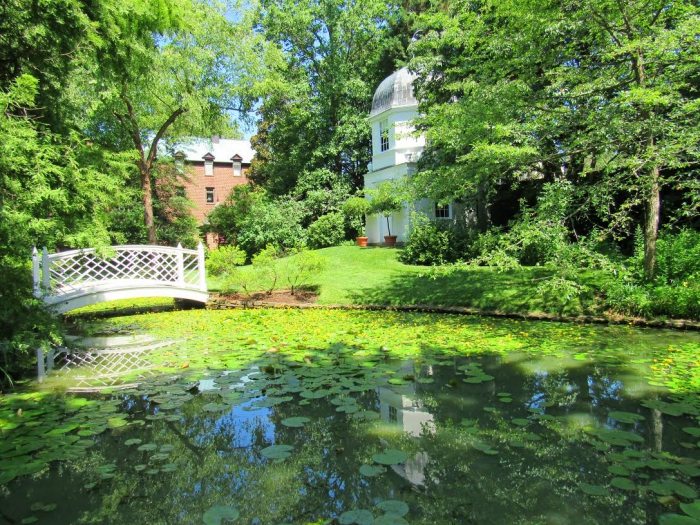“Soon as I’m done with this row, I’ll set down my hoe and settle down on the grass a bit. These salad greens are coming along, but the weeds do grow everywhere. Maybe we’ll get some good squash to feed Mr. Paca and all of us who work for him. It’s warm today—I’ll just draw a cup of water to drink from the spring before I carry water for these plants. That springhouse in the back sure is a good thing so we don’t need to carry our buckets too far.
Listen to those birds in the trees around here. I sure like hearing the morning doves and seeing the martins fly by, especially when they eat up the mosquitoes down there by the fishpond. Mr. Paca does know how to pick his seeds to make the prettiest place in town. Good that it’s all behind this fine brick wall to keep the wild critters out, us being so close to the wilderness out there.”
 Paca House and Garden
Paca House and Garden
If this young gardener could time travel to the year 2016, he would find himself tending a present-day garden looking very much as it did back in his lifetime before the American Revolution. The William Paca House and Garden date to the 1760s, when William Paca and his wealthy wife Mary Chew constructed their grand brick mansion on Prince George Street in Annapolis. Mr. Paca was a colonial leader, lawyer, judge, legislator, founder of the Sons of Liberty, and—most famously—signer of the Declaration of Independence.
The two-acre William Paca Garden is a gardener’s oasis nestled in the streets of historic Annapolis. Mr. Paca’s luxurious colonial enclave has been researched and restored to its original form using evidence from archeological digs and garden details seen in the background of Charles Willson Peale’s 1772 portrait of Paca.
A Summer Garden Visit
On a blistering hot and sunny weekday morning, I had the garden to myself, sharing its peaceful beauty only with staff gardener Ben Cornwell. I found Ben contentedly weeding along the edge of the pretty fish-shaped lily pond in the wilderness section of the garden. The natural garden lies at the downhill end of the property, accessed via flat terraces that step down from the house in a series of structured “parterres.”
 Paca House Gardener Ben Cornwell
Paca House Gardener Ben Cornwell
Par terre is French for “on the ground,” and a formal parterre garden is a symmetrical pattern of planting beds often connected by geometric pathways lined by clipped hedges. Designed to be viewed from above to demonstrate human control over nature, this garden design form originated in France, became popular in England, and migrated to the American colonies. Since then, the stylized parterre has gradually been replaced in America by the English landscape garden, with more natural curves, mixed native and imported plants, picturesque water features, architectural focal points, and sweeps of lawn set against groves of trees.
Behind its brick walls, the William Paca Garden offers us both worlds: structured parterres and a naturalized “wilderness” garden. Gardening inside this walled enclosure is Ben Cornwell’s “dream job,” as seen in his total immersion in the garden’s seasons and knowledge of its history and horticulture.
 Paca House Garden in full bloom
Paca House Garden in full bloom
As I wandered the meticulously maintained terraces, what I noticed most was the soothing quiet. Oh sure, there were the sounds of cars and trucks on King George Street just behind the brick wall. There were the chimes resonating from the nearby Naval Academy Chapel and the Saint Anne’s Church steeple. There was the toot of the Harbor Queen tour boat’s hourly departure for tours of the Annapolis Harbor. But almost disguising these modern reminders were the soft coos and birdsong of countless feathered garden residents finding respite in this green oasis. Even amidst the birdsong and the modern background sounds, the garden just felt somehow …quiet.
The Terraced Garden
Stepping from the mansion into the walled garden, you find yourself on the uppermost terrace, designed for entertaining and viewing the garden. The next two levels are laid out in four unique geometric gardens called the Rose, Flower, Holly, and Boxwood Parterres. The smells of turned earth, fresh flowers, and musky boxwood travel with you along the geometric paths.
To the side lie a kitchen garden and an espaliered fruit tree garden. Heirloom roses, shrubs, perennials, and annuals in the parterres reflect what would have been available in colonial days, as revealed by 18th- century books and letters.
 Paca House pond
Paca House pond
At the base of the garden lies the wilderness garden, with its focal point dovecote summerhouse, reconstructed from the Paca portrait. The shady garden includes a pretty white latticework bridge over the large fish-shaped pond. In the corners are a reconstructed bath house and a spring house covering a still functioning natural spring, a valuable asset in colonial days before public water systems. In Paca’s time, the spring water sustained the household, watered the garden, fed the fish pond, and supplied the bath house.
Mr. Paca also designed a brick canal to channel storm water runoff from neighboring properties and regular flooding from Spa Creek. Even today, tidal flooding occurs surprisingly often and can inundate the fish pond and wilderness garden.
Plan a Visit
Today you can visit this mansion and its beautiful garden, thanks to the work of Historic Annapolis to preserve and restore them. The State of Maryland owns the property, and Historic Annapolis manages it, having saved the building from its former use as the Carvel Hotel and subsequent threatened destruction. Historic Annapolis professional staff continue to research and carefully restore the house and garden to their former grandeur.
The house and gardens are open for tours and serve as a popular venue for weddings and other events. The annual Paca Garden Plant Sale on Mother’s Day weekend draws huge crowds of gardeners each year. For more information, click here.
William Paca House and Garden
186 Prince George Street, Annapolis, MD 21401 Hours and Admission: Open daily late March through December Monday–Saturday: 10:00am– 5:00pm Sunday: Noon–5:00pm Last tour begins at 4:00pm, and group tours are arranged by appointment. $10 – Guided house tour and self-guided garden tour $ 8 – Guided house tour of 1st floor and self-guided garden tour $ 5 – Self-guided garden tour
Photos courtesy of Ann Powell








